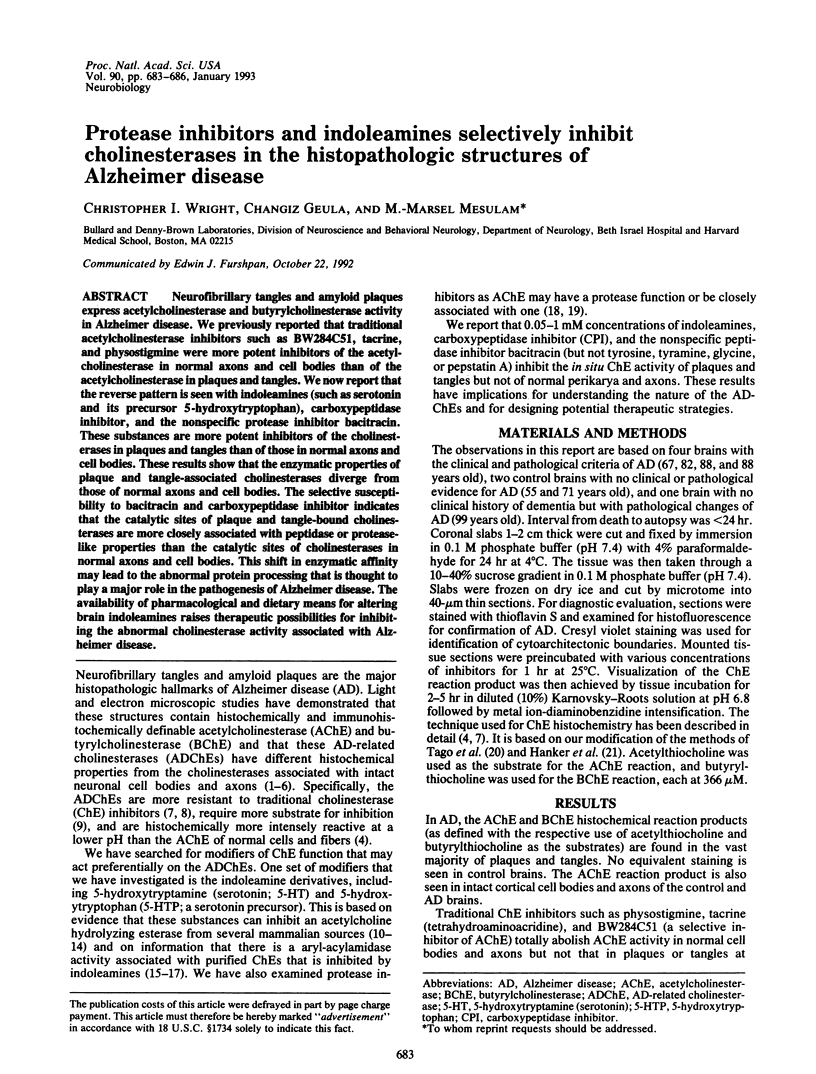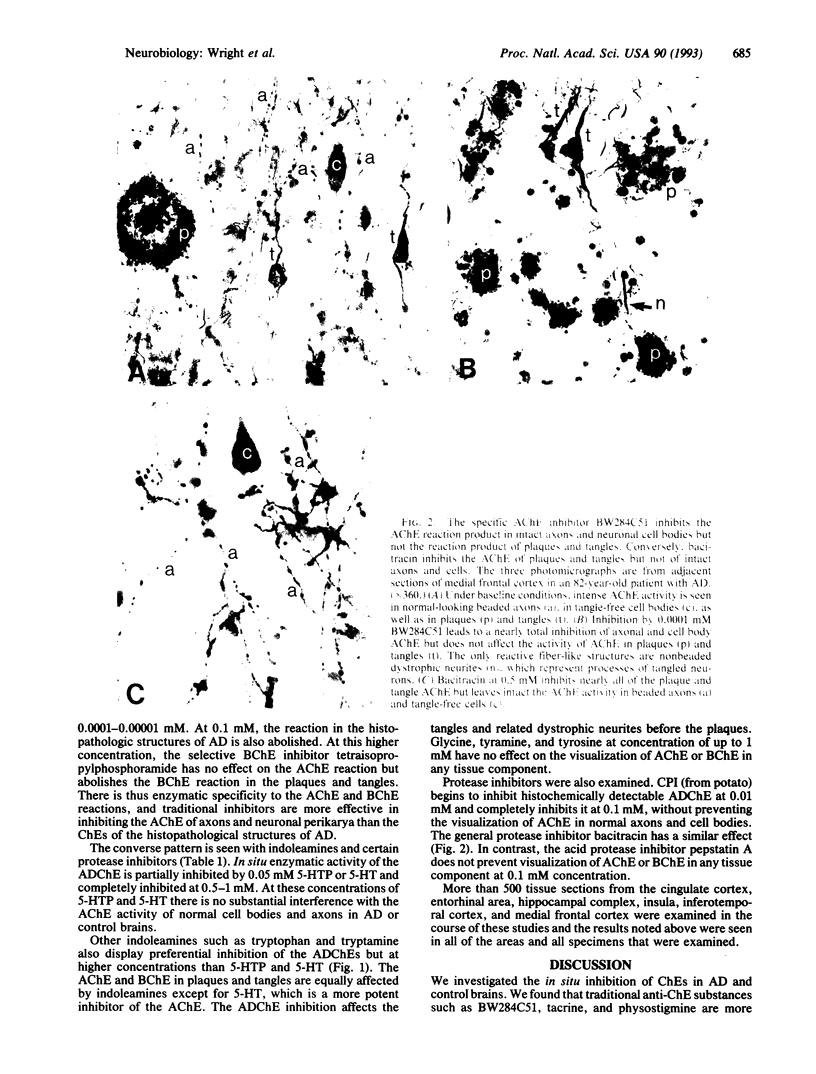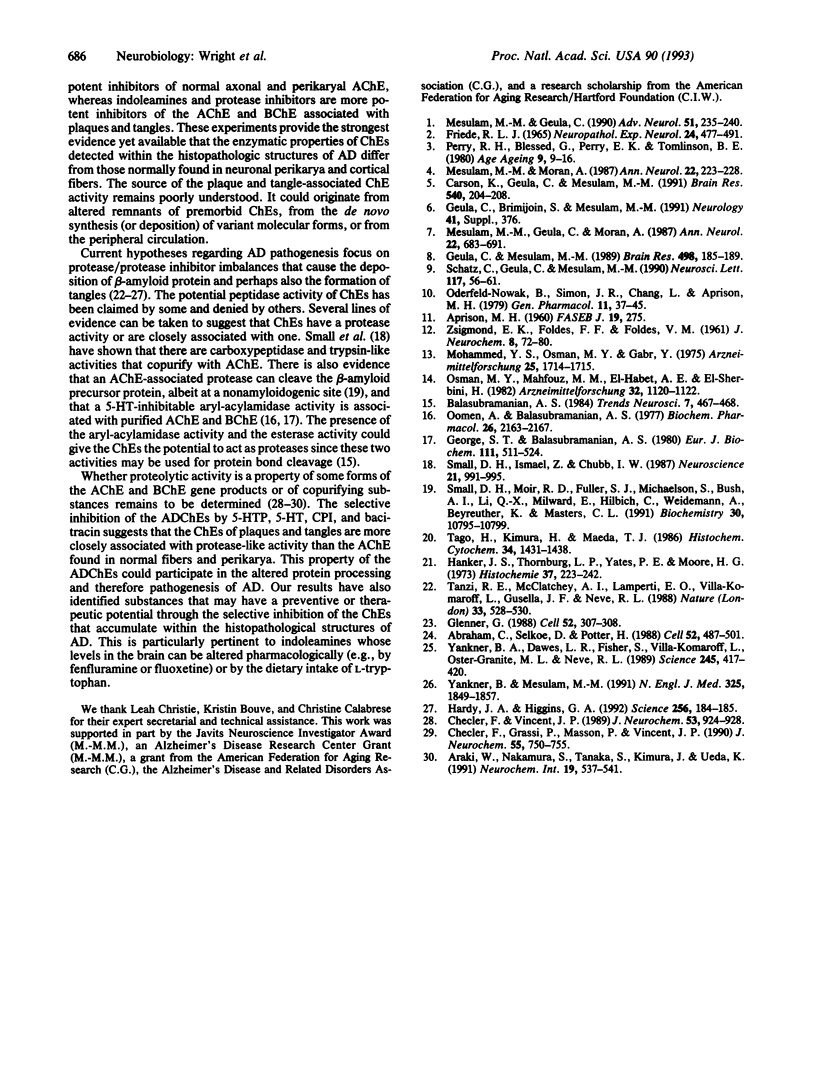Abstract
Neurofibrillary tangles and amyloid plaques express acetylcholinesterase and butyrylcholinesterase activity in Alzheimer disease. We previously reported that traditional acetylcholinesterase inhibitors such as BW284C51, tacrine, and physostigmine were more potent inhibitors of the acetylcholinesterase in normal axons and cell bodies than of the acetylcholinesterase in plaques and tangles. We now report that the reverse pattern is seen with indoleamines (such as serotonin and its precursor 5-hydroxytryptophan), carboxypeptidase inhibitor, and the nonspecific protease inhibitor bacitracin. These substances are more potent inhibitors of the cholinesterases in plaques and tangles than of those in normal axons and cell bodies. These results show that the enzymatic properties of plaque and tangle-associated cholinesterases diverge from those of normal axons and cell bodies. The selective susceptibility to bacitracin and carboxypeptidase inhibitor indicates that the catalytic sites of plaque and tangle-bound cholinesterases are more closely associated with peptidase or protease-like properties than the catalytic sites of cholinesterases in normal axons and cell bodies. This shift in enzymatic affinity may lead to the abnormal protein processing that is thought to play a major role in the pathogenesis of Alzheimer disease. The availability of pharmacological and dietary means for altering brain indoleamines raises therapeutic possibilities for inhibiting the abnormal cholinesterase activity associated with Alzheimer disease.
Full text
PDF



Images in this article
Selected References
These references are in PubMed. This may not be the complete list of references from this article.
- Abraham C. R., Selkoe D. J., Potter H. Immunochemical identification of the serine protease inhibitor alpha 1-antichymotrypsin in the brain amyloid deposits of Alzheimer's disease. Cell. 1988 Feb 26;52(4):487–501. doi: 10.1016/0092-8674(88)90462-x. [DOI] [PubMed] [Google Scholar]
- Carson K. A., Geula C., Mesulam M. M. Electron microscopic localization of cholinesterase activity in Alzheimer brain tissue. Brain Res. 1991 Feb 1;540(1-2):204–208. doi: 10.1016/0006-8993(91)90508-s. [DOI] [PubMed] [Google Scholar]
- Checler F., Grassi J., Masson P., Vincent J. P. Monoclonal antibodies allow precipitation of esterasic but not peptidasic activities associated with butyrylcholinesterase. J Neurochem. 1990 Sep;55(3):750–755. doi: 10.1111/j.1471-4159.1990.tb04555.x. [DOI] [PubMed] [Google Scholar]
- Checler F., Vincent J. P. Peptidasic activities associated with acetylcholinesterase are due to contaminating enzymes. J Neurochem. 1989 Sep;53(3):924–928. doi: 10.1111/j.1471-4159.1989.tb11793.x. [DOI] [PubMed] [Google Scholar]
- George S. T., Balasubramanian A. S. The identity of the serotonin-sensitive aryl acylamidase with acetylcholinesterase from human erythrocytes, sheep basal ganglia and electric eel. Eur J Biochem. 1980 Oct;111(2):511–524. doi: 10.1111/j.1432-1033.1980.tb04967.x. [DOI] [PubMed] [Google Scholar]
- Geula C., Mesulam M. Special properties of cholinesterases in the cerebral cortex of Alzheimer's disease. Brain Res. 1989 Sep 25;498(1):185–189. doi: 10.1016/0006-8993(89)90419-8. [DOI] [PubMed] [Google Scholar]
- Glenner G. G. Alzheimer's disease: its proteins and genes. Cell. 1988 Feb 12;52(3):307–308. doi: 10.1016/s0092-8674(88)80021-7. [DOI] [PubMed] [Google Scholar]
- Hanker J. S., Thornburg L. P., Yates P. E., Moore H. G., 3rd The demonstration of cholinesterases by the formation of osmium blacks at the sites of Hatchett's brown. Histochemie. 1973 Jun;37(3):223–242. doi: 10.1007/BF00304184. [DOI] [PubMed] [Google Scholar]
- Hardy J. A., Higgins G. A. Alzheimer's disease: the amyloid cascade hypothesis. Science. 1992 Apr 10;256(5054):184–185. doi: 10.1126/science.1566067. [DOI] [PubMed] [Google Scholar]
- Mesulam M. M., Asuncion Morán M. Cholinesterases within neurofibrillary tangles related to age and Alzheimer's disease. Ann Neurol. 1987 Aug;22(2):223–228. doi: 10.1002/ana.410220206. [DOI] [PubMed] [Google Scholar]
- Mesulam M. M., Geula C., Morán M. A. Anatomy of cholinesterase inhibition in Alzheimer's disease: effect of physostigmine and tetrahydroaminoacridine on plaques and tangles. Ann Neurol. 1987 Dec;22(6):683–691. doi: 10.1002/ana.410220603. [DOI] [PubMed] [Google Scholar]
- Mesulam M. M., Geula C. Shifting patterns of cortical cholinesterases in Alzheimer's disease: implications for treatment, diagnosis, and pathogenesis. Adv Neurol. 1990;51:235–240. [PubMed] [Google Scholar]
- Mohammed Y. S., Osman M. Y., Gabr Y. Inhibition of cholinesterase by 5-hydroxytryptamine. Arzneimittelforschung. 1975 Nov;25(11):1714–1715. [PubMed] [Google Scholar]
- Oderfeld-Nowak B., Simon J. R., Chang L., Aprison M. H. Interactions of the cholinergic and serotonergic systems: re-evaluation of conditions for inhibition of acetylcholinesterase by serotonin and evidence for a new inhibitor derived from this natural indoleamine. Gen Pharmacol. 1980;11(1):37–45. doi: 10.1016/0306-3623(80)90010-5. [DOI] [PubMed] [Google Scholar]
- Oommen A., Balasubramanian A. S. The inhibition of brain aryl acylamidase by 5-hydroxytryptamine and acetylcholine. Biochem Pharmacol. 1977 Nov 15;26(22):2163–2167. doi: 10.1016/0006-2952(77)90269-6. [DOI] [PubMed] [Google Scholar]
- Osman M. Y., Mahfouz M. M., El-Habet A. E., El-Sherbini H. Inhibition of erythrocyte and plasma cholinesterase by 5-hydroxytryptamine. Arzneimittelforschung. 1982;32(9):1120–1122. [PubMed] [Google Scholar]
- Perry R. H., Blessed G., Perry E. K., Tomlinson B. E. Histochemical observations on cholinesterase activities in the brains of elderly normal and demented (Alzheimer-type) patients. Age Ageing. 1980 Feb;9(1):9–16. doi: 10.1093/ageing/9.1.9. [DOI] [PubMed] [Google Scholar]
- Ramakrishna T. V., Balasubramanian N. Spectrophotometric determination of nitrite. Z Gesamte Hyg. 1984 Aug;30(8):467–468. [PubMed] [Google Scholar]
- Schätz C. R., Geula C., Mesulam M. Competitive substrate inhibition in the histochemistry of cholinesterase activity in Alzheimer's disease. Neurosci Lett. 1990 Sep 4;117(1-2):56–61. doi: 10.1016/0304-3940(90)90119-t. [DOI] [PubMed] [Google Scholar]
- Small D. H., Ismael Z., Chubb I. W. Acetylcholinesterase exhibits trypsin-like and metalloexopeptidase-like activity in cleaving a model peptide. Neuroscience. 1987 Jun;21(3):991–995. doi: 10.1016/0306-4522(87)90053-4. [DOI] [PubMed] [Google Scholar]
- Small D. H., Moir R. D., Fuller S. J., Michaelson S., Bush A. I., Li Q. X., Milward E., Hilbich C., Weidemann A., Beyreuther K. A protease activity associated with acetylcholinesterase releases the membrane-bound form of the amyloid protein precursor of Alzheimer's disease. Biochemistry. 1991 Nov 5;30(44):10795–10799. doi: 10.1021/bi00108a027. [DOI] [PubMed] [Google Scholar]
- Tago H., Kimura H., Maeda T. Visualization of detailed acetylcholinesterase fiber and neuron staining in rat brain by a sensitive histochemical procedure. J Histochem Cytochem. 1986 Nov;34(11):1431–1438. doi: 10.1177/34.11.2430009. [DOI] [PubMed] [Google Scholar]
- Tanzi R. E., McClatchey A. I., Lamperti E. D., Villa-Komaroff L., Gusella J. F., Neve R. L. Protease inhibitor domain encoded by an amyloid protein precursor mRNA associated with Alzheimer's disease. Nature. 1988 Feb 11;331(6156):528–530. doi: 10.1038/331528a0. [DOI] [PubMed] [Google Scholar]
- Yankner B. A., Dawes L. R., Fisher S., Villa-Komaroff L., Oster-Granite M. L., Neve R. L. Neurotoxicity of a fragment of the amyloid precursor associated with Alzheimer's disease. Science. 1989 Jul 28;245(4916):417–420. doi: 10.1126/science.2474201. [DOI] [PubMed] [Google Scholar]
- Yankner B. A., Mesulam M. M. Seminars in medicine of the Beth Israel Hospital, Boston. beta-Amyloid and the pathogenesis of Alzheimer's disease. N Engl J Med. 1991 Dec 26;325(26):1849–1857. doi: 10.1056/NEJM199112263252605. [DOI] [PubMed] [Google Scholar]




